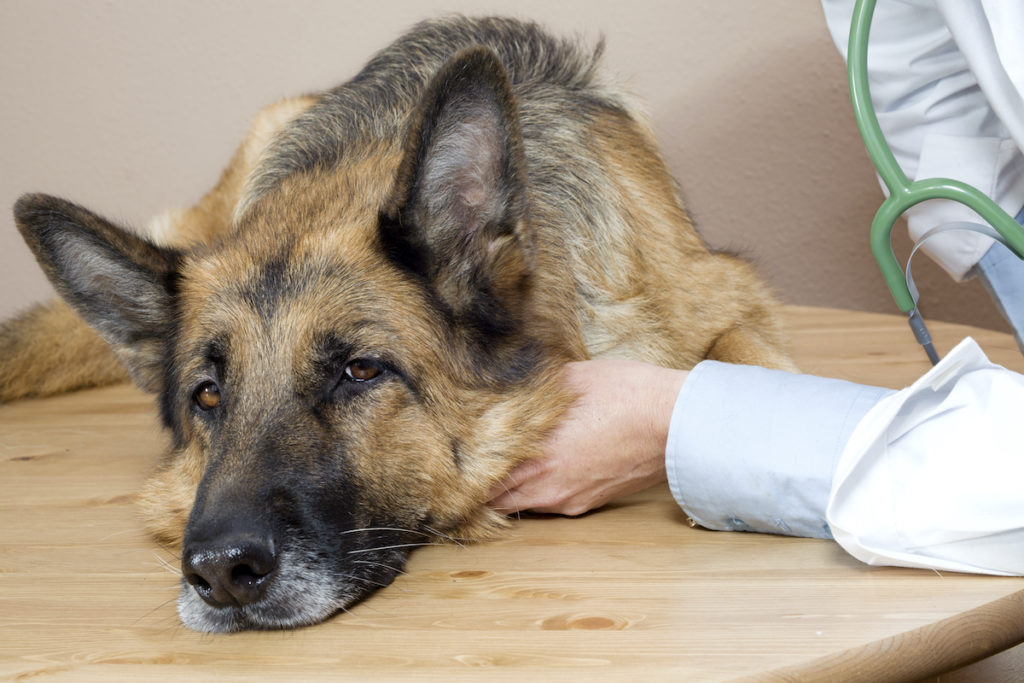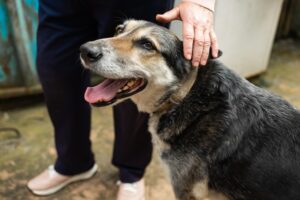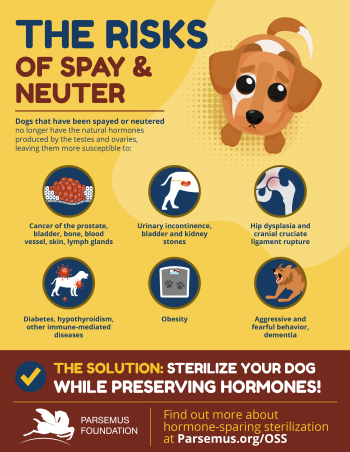
Project Summary: How Spaying and Neutering Affect Health
Spaying and neutering pets to reduce pet overpopulation is standard veterinary practice, and usually involves removal of the sex organs to sterilize the animal. More recent research on dogs has shown that the lack of natural hormones resulting from spay/neuter can lead to other serious health complications. This page provides an overview of the research on the health effects of spay or neuter. Hormone-sparing methods — like hysterectomy (also called ovary-sparing spay) for females and vasectomy for males — are ways to sterilize pets without the negative impacts from hormone loss.
The World Small Animal Veterinary Association published a complete review in 2024: Guidelines for the control of reproduction in dogs and cats.
Use our Veterinarian Directory to find a veterinarian near you who offers hormone-sparing sterilization.
Infographic on the risks of spay and neuter, which you can use to raise awareness
Project Topics
Health problems after hormone loss in dogs
Our understanding of the health impacts of spay and neuter started with research evaluating dogs that had their sex organs removed (called gonadectomy) at a very young age. In 2007, a respected veterinarian named Margaret Root Kustritz published a review of spaying and neutering dogs and cats at different ages. This generated a lot of discussion and further research reporting positive and negative health consequences of gonadectomy that vary by age, gender, and breed.
Today there is mounting evidence that the health benefits of keeping the sex organs in dogs may outweigh the health risks. A key 2013 publication from the University of California, Davis reported that the rates of two joint disorders and three cancers in Golden Retrievers were significantly higher in both males and females that were neutered early or late compared with intact (non-neutered) dogs. Many other studies have followed. For example, a 2014 study indicated that gonadectomized Vizslas had significantly increased odds of developing mast cell cancer, lymphoma, all other cancers, and fear of storms compared with the odds for sexually intact dogs. Brain tumors are also 11 times more likely in spayed than intact females. On the positive side, since dogs who have been spayed or neutered no longer have sex organs, they don’t get diseases associated with sex organs or hormones.
There is also evidence that it is the loss of hormones from spaying and neutering dogs that is causing an increased risk of long-term health problems. A study by Zink and colleagues reported that intact dogs and those sterilized with hormone-sparing procedures (vasectomy or hysterectomy) had reduced risk of general health problems and both problematic and nuisance behaviors as compared to spayed or neutered dogs.
Whether your dog might have health problems following spay or neuter depends on many factors, including the breed, sex, age of sterilization, and body size. Follow-up studies from the University of California, Davis have reported risk profiles of 35 breeds and mixed breed dogs, providing important information for veterinarians and pet-owners when considering sterilization. If you are considering sterilization options for your dog, consult with an experienced veterinarian to discuss the risks and benefits for your dog. And be sure to consider hormone-sparing sterilization procedures in your assessment. The following table summarizes our current knowledge of potential positive and negative health impacts.
Summary of health impacts of spaying and neutering (gonadectomy):
| Lower chance of: | But higher chance of: |
|---|---|
Diseases of the sex organs:
|
|
How does spaying and neutering impact health?
A significant contributor to the negative health impacts of removing the hormone-producing sex organs in dogs is that the natural feedback mechanisms become unregulated. Normally, the hypothalamus and pituitary glands in the brain stimulate the production of luteinizing hormone (LH). The LH surge then stimulates the production of steroid hormones (like estrogen, progesterone or testosterone) from the gonads. Without the ovaries or testes, there is no feedback signal to the brain to reduce production, so LH continues to be produced and may be the reason for diverse health problems. A study by Zwida and Kutzler in 2016 reported on the health implications of high LH levels in dogs without gonads. A review article on the ailments associated with spay and neuter — and the connection with LH — was also published by Kutzler.
As a result of the health problems that occur more frequently after gonadectomy, pet owners and veterinarians have sought alternatives. That is where hormone-sparing sterilization comes in. Ovary-sparing spay (or hysterectomy) for females and vasectomy for males are surgical methods that sterilize the pet while preserving the organs (ovaries and testes) that produce natural hormones. These options are great for breeds known to have greater risk of certain problems after spay/neuter (for example, Boxers have a higher chance of brain tumors, Rottweilers and giant breeds are prone to bone cancers, and Golden Retrievers have higher chances of orthopedic conditions and cancer after hormone loss).
Don’t hormones cause undesirable dog behavior?
Many people believe that neutered male dogs make better pets because they are less aggressive. However, research does not support this conclusion. A recent large survey reported that spayed or neutered dogs did not differ from intact dogs in terms of aggression directed toward familiar people or pets, and they actually showed higher levels of aggression toward strangers. Dog aggression is a main reason for relinquishment to shelters, and neutered male dogs are more often surrendered for behavioral reasons. Gonadectomized dogs may also develop more anxiety and fear, and show more cognitive decline than intact dogs.
Behavior is complex and related to the dog’s environment, rearing, and training. Neutering male dogs may decrease reproductive-related behaviors (urine marking, mounting and roaming) but impacts on other behaviors are variable.
Take Action on How Spaying and Neutering Affect Health
For Veterinarians
- Veterinarians who wish to be listed in the directory may do so by filling out the info on the clinic registration form.
- Use this flyer as an informational piece for your website or as a handout for clients.
- Email us at info@parsemusfoundation.org if you would like to consult with a veterinarian who is experienced with hormone-sparing sterilization.
- Review the Additional Resources below. Take note of the information about gonadectomy risks for specific breeds and mixed-breed dogs published by Hart and colleagues (2020) and stay abreast of recent updates in this rapidly evolving area of research.
For Pet Owners
- Review this flyer to understand whether hormone-sparing sterilization is right for you and your dog. Keep in mind that impacts vary on breed, size and other factors. Check the recent publications about cancer and joint disorders by dog breed and mixed-breed size.
- Consult with a veterinarian who is familiar with the health issues related to spay/neuter and familiar with hormone-sparing options. Each dog and family is different, and having an expert consultation on the best method of sterilizing your dog is important.
- To find a provider you can search the Veterinary Directory or check the information at the Ovary Sparing Spay and Vasectomy Info Facebook Group. If you cannot find a provider nearby, you could pass along the information on this website to your own veterinarian and ask if he or she can provide the procedure. Direct him or her to the information on this website and email us at info@parsemusfoundation.org if additional assistance/advice is required.
- Please let us know if you find a veterinarian who offers OSS or vasectomy and would like to join our directory!
- If you choose to preserve your dog’s hormones, consider joining this Facebook group: Training and behavioral advice for Intact Dogs.
Veterinarians Offering Alternative Methods of Contraception
For Pet Owners
Looking for a veterinarian willing to perform procedures beyond surgical spay or neuter? Browse our directory of qualified veterinary professionals.
For Veterinarians
Do you offer alternative methods of contraception like ovary-sparing spay and vasectomy? Join our referral directory so new clients can find you.
Additional Resources
Summary documents
- Download our flyer for a brief overview of hormone-sparing sterilization.
- Download our infographic on the risks of spay-neuter.
Select publications on health impacts of gonadectomy
- For a video overview of the topic: Michelle Kutzler 2021 Presentations at AMVAC Conference.
- Belfield WO. 1972.For a more normal life for a pet: Partial spay (hysterectomy).Vet Med Small Anim Clin
67(11):1223-4. Full text. First publication covering why and how to conduct a partial spay on dogs. - Brent L. 2019. Growing interest in hormone sparing dog sterilization and recommendations for standard identification methods. Clin Theriogenology 11(3):247-253. Full text.
- Brent L, Kutzler M. 2018. Alternatives to traditional spay and neuter – evolving best practices in dog sterilization. Innovative Vet Care. Free full text.
- de la Riva GT, Hart B, et al. 2013. Neutering dogs: Effects on joint disorders and cancers in Golden Retrievers. PLoS One. Free full text.
- Farhoody P, Mallawaarachchi I, et al. 2018. Aggression toward familiar people, strangers, and conspecifics in gonadectomized and intact dogs. Front Vet Sci 5:1-13. Free full text.
- Hart BL. 2001. Effect of gonadectomy on subsequent development of age-related cognitive impairment in dogs. J Am Vet Med Assoc 219:51-6. Abstract.
- Hart BL, Hart A, et al. 2014. Long-term health effects of neutering dogs: comparison of Labrador Retrievers with Golden Retrievers. PLoS One 9(7). Free full text.
- Hart BL, Hart A, et al., 2020. Assisting decision-making on age of neutering for 35 breeds of dogs: Associated joint disorders, cancers, and urinary incontinence. Front Vet Sci 07 July, 2020. Free full text. Supplementary data by breed.
- Hart BL, Hart A, et al., 2020. Assisting decision-making on age of neutering for mixed-breed dogs in five weight categories: Associated joint disorders and cancers. Front Vet Sci 31 July, 2020. Free full text. Supplementary data by weight.
- Hart LA, Hart BL, Thigpen AP. 2023. Decision-making on recommended age of spay/neuter for a specific dog. Vet Clin North Am Small Anim Pract 53(5):1209-1221. Abstract.
- Joonè CJ, Konovalov DA. 2023. The effect of neuter status on longevity in the Rottweiler dog. Sci Rep 13: 17845. Free full text.
- Kutzler M. 2020. Possible relationship between long-term adverse health effects of gonad-removing surgical sterilization and luteinizing hormone in dogs. Animals. Free full text.
- Kutzler M. 2022. Understanding the effects of sustained supraphysiologic concentrations of luteinizing hormone in gonadectomized dogs: What we know and what we still need to learn. Theriogenology 196:270-274. Free full text.
- Lissner E. 2013. “The pros of partial spay. Innovative Vet Care. Full text.
- Mattravers M. 2017. Ovary sparing spay in canines: An alternative to traditional ovariohysterectomy. Full text. Student review.
- Romagnoli S, Krekeler K, de Cramer K, et al., 2024. WSAVA guidelines for the control of reproduction in dogs and cats. J Small Anim Prac. May 28, 2024. Full text.
- Society for Theriogenology, Board of Directors, and the American College of Theriogenology. 2013. Basis for Position on Mandatory Spay-Neuter in the Canine and Feline. Free full text. A good review of the data and recommendations from veterinarians who specialize in reproduction.
- Urfer SR, Kaemberlein M. 2019. Desexing dogs: A review of the current literature. Animals 9(12):1086. Free full text.
- Waters DJ, Kengeri SS, Clever B, et al. 2009. Exploring mechanisms of sex differences in longevity: lifetime ovary exposure and exceptional longevity in dogs. Aging Cell 8:752–755. Free full text.
- Zink MC, Farhoody P, et al. 2014. Evaluation of the risk and age of onset of cancer and behavioral disorders in gonadectomized Vizslas. Abstract.
- Zink, MC. 2020. Canine gonadectomy: Rethinking long held beliefs. YouTube video.
- Zink MC, Delgado MM, Stella JL. 2023. Vasectomy and ovary-sparing spay in dogs: comparison of health and behavior outcomes with gonadectomized and sexually intact dogs. AVMA. Jan 19, 2023. Free full text.
- Zwida K, Kutzler M. 2016. Non-reproductive long-term health complications of gonad removal in dogs as well as possible causal relationships with post-gonadectomy elevated luteinizing hormone ( LH ) concentrations. J Etiol Anim Health 1(1):1-11. Full text.
- Last updated on November 14, 2024
Tell us what you think
What People Are Saying
I am so thankful for this site. I have referred people to you for years. … I’ve told people about the option of hormone-sparing surgeries and also managing their intact animals with integrity and compassion. I look at your site and tell them about veterinarians near them who can do these surgeries.
Website Visitor
Laparoscopic ovariectomy in cats is safe, can be performed in a comparable amount of time as traditional ovariohysterectomy, and may result in less postoperative discomfort.
Case et al.
The societal practice in the U.S. of dog neutering contrasts with the general attitudes in many European countries, where neutering is commonly avoided and not generally promoted by animal health authorities.
Torres de la Riva, et al.
Based upon the review of the literature, it becomes clear that canine gonads are not merely reproductive organs but critical to endocrine, musculoskeletal, behavior, and antineoplastic health.
Zwida & Kutzler
Recent scientific studies demonstrate that spaying/neutering, particularly before a dog is fully mature, may result in detrimental long-term health impacts. In light of this information, AKC encourages breeders, owners and veterinarians to consult on the appropriateness and timing of spaying or neutering an individual dog.
AKC Position Statement on Spaying and Neutering
About the only positive effect on behavior that seems to result from spaying and neutering is the roughly 68 percent decrease in urine marking.
Stanley Coren Ph.D., F.R.S.C
Thought leaders are beginning to accept that spay and neuter have both positive and negative health consequences that vary by age, gender and breed.
Elaine Lissner
Pet Health News

Cognitive dysfunction syndrome in cats similar to Alzheimer’s disease
House cats live an average of 14 years, and it’s not uncommon for a cat to live more than 20 years. Older cats often develop cognitive decline resulting in dementia. It’s called “cognitive dysfunction syndrome” or CDS. This condition is similar in many ways to Alzheimer’s disease, including amyloid beta and tau protein accumulation. Some believe that environmental stressors from life as a house cat contribute to cognitive decline.

Noninvasive methods to evaluate canine BPH
Most intact male dogs will develop enlarged prostate glands. This condition, known as benign prostatic hyperplasia (BPH), is influenced by androgen hormones such as testosterone. BPH has few symptoms in the earlier stages of development. However, it can lead to serious health issues if left untreated, such as reproductive tract issues, constipation, and prostate infections. Researchers have outlined noninvasive methods to evaluate canine BPH in the early, subclinical, stages. Early detection allows early treatment and avoids the progression of the disease.

Additional support for delaying spay/neuter in large-breed dogs
When it comes to spaying or neutering your dog, the timing of the procedure can significantly impact their long-term health. Traditionally, veterinarians have recommended spaying or neutering before six months of age. However, recent studies, including an update to the comprehensive studies by Drs. Benjamin and Lynette Hart from the University of California, Davis, have added to growing evidence that delaying these procedures can reduce the risk of cancer and joint disorders in certain breeds. Pet owners should also consider hormone-sparing sterilization as an alternative to traditional spay/neuter.

Cognitive dysfunction syndrome in cats similar to Alzheimer’s disease
House cats live an average of 14 years, and it’s not uncommon for a cat to live more than 20 years. Older cats often develop cognitive decline resulting in dementia. It’s called “cognitive dysfunction syndrome” or CDS. This condition is similar in many ways to Alzheimer’s disease, including amyloid beta and tau protein accumulation. Some believe that environmental stressors from life as a house cat contribute to cognitive decline.

Noninvasive methods to evaluate canine BPH
Most intact male dogs will develop enlarged prostate glands. This condition, known as benign prostatic hyperplasia (BPH), is influenced by androgen hormones such as testosterone. BPH has few symptoms in the earlier stages of development. However, it can lead to serious health issues if left untreated, such as reproductive tract issues, constipation, and prostate infections. Researchers have outlined noninvasive methods to evaluate canine BPH in the early, subclinical, stages. Early detection allows early treatment and avoids the progression of the disease.

Additional support for delaying spay/neuter in large-breed dogs
When it comes to spaying or neutering your dog, the timing of the procedure can significantly impact their long-term health. Traditionally, veterinarians have recommended spaying or neutering before six months of age. However, recent studies, including an update to the comprehensive studies by Drs. Benjamin and Lynette Hart from the University of California, Davis, have added to growing evidence that delaying these procedures can reduce the risk of cancer and joint disorders in certain breeds. Pet owners should also consider hormone-sparing sterilization as an alternative to traditional spay/neuter.

Veterinarian raises awareness about the benefits of hormones
Veterinary advances (such as hormone-sparing sterilization) can be slow to reach caring pet owners. Fortunately, some veterinarians — like Peter Dobias, DVM — are not



